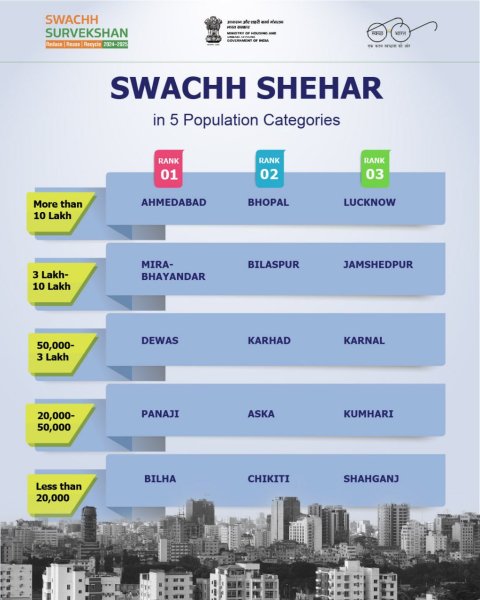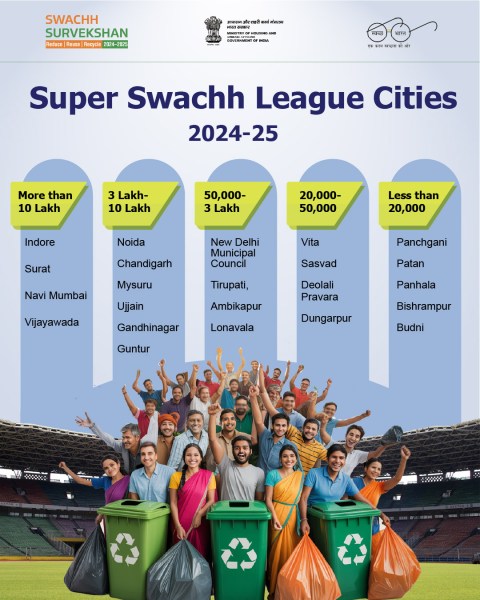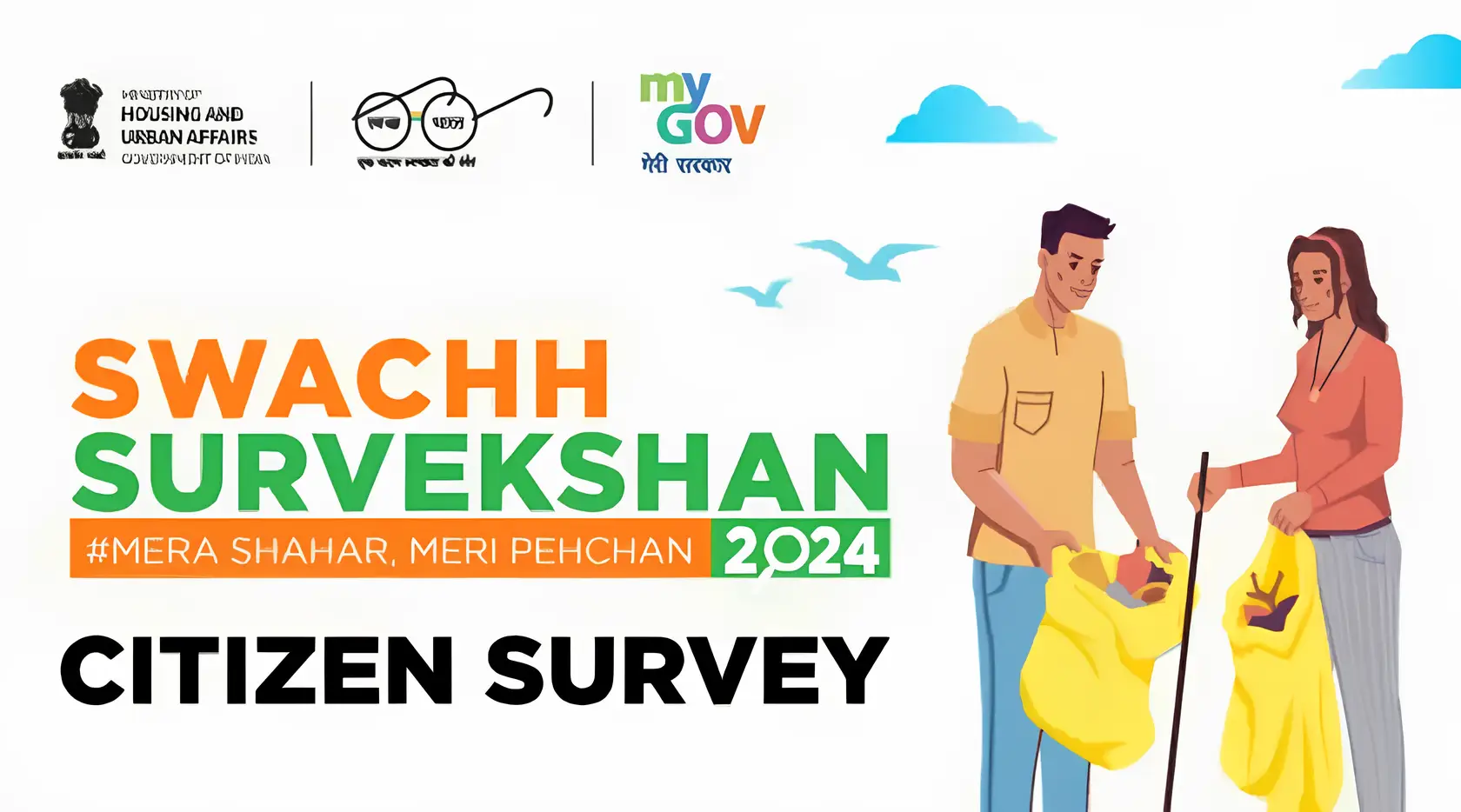Why in the news?
Ahmedabad was named the cleanest big city in the country in the Swachh Survekshan 2024-25 awards, followed by Bhopal and Lucknow. President Droupadi Murmu presented the award to Ahmedabad for being the top city among those with a population of 10 lakh or above during the awards ceremony held at Vigyan Bhagwan, New Delhi.
Key Takeaways:
1. The goal of this survey is to encourage citizen participation and create awareness among all sections of society about the importance of working together in creating clean cities and towns to reside in. It is conducted under the ambit of the Swachh Bharat Mission (Urban).
2. The 9th edition of Swachh Survekshan (SS) awards, which was announced by the President, has a revamped format. With Indore winning the tag of cleanest city for seven years in a row, Union Housing and Urban Affairs Minister Manohar Lal Khattar said last year that the next round of the Swachhata rankings will have a separate category for cities that have been ranked number one in the past, leaving the general competition open for new winners.
3. To address it, in this 9th edition of SS, a special category – Super Swachh League has been introduced, creating a separate league of cities excelling in cleanliness. This category recognises the cities that had been in the top three of their categories in the previous three years.
4. This new category, Super Swachh League Cities, included the previous winners Indore, Surat, and Navi Mumbai. Last year, Indore and Surat were jointly recognised as the cleanest cities, with Indore maintaining its top position for the seventh consecutive time.
5. It also said that for the first time ever, cities were classified into five population-based categories:
(i) Very Small Cities (< 20,000 population)
(ii) Small Cities (20,000 – 50,000 population)
(iii) Medium Cities (50,000 – 3 Lakh population)
(iv) Big Cities (3 – 10 Lakh population)
(v) Million Plus Cities ( > 10 Lakh population)
5. Also, the Indicators have been simplified and structured into ten comprehensive sections, which cover the entire spectrum of urban sanitation and cleanliness. To maintain sanitation standards in key public spaces, a special emphasis has been placed on tourist destinations and high-footfall areas.

6. With the theme of ‘Reduce, Reuse and Recycle (3R), the focus is on minimising wastage by using minimum resources and re-using them for the same purpose or other purposes. It also aligns with the Jaipur declaration, which was unanimously adopted at the 12th Regional 3R and Circular Economy Forum in Asia and the Pacific in March this year.
7. The awards were presented across four categories: Super Swachh League Cities, the top three clean cities in five population categories, Special category, and State-level awards – Promising clean city of the state/UT.
In the special category:
↪ The Cleanest Ganga Town Award was given to Prayagraj.
↪ The Cleanest Cantonment Board Award was given to Secunderabad Cantt.
↪ The Safaimitra Surakshit Shehar Awards were given to Gvmc Visakhapatnam, Jabalpur, And Gorakhpur.
↪ A special mention was given in recognition of the special initiative of Swachh Mahakumbh 2025.

BEYOND THE NUGGET: Swachh Bharat Mission
1. Last year, Swachh Bharat Mission completed its 10 years on 2nd October. This was one of the first programmes announced by Prime Minister Narendra Modi after he took office in 2014.
2. The mission was divided into SBM-Gramin for villages, and SBM-Urban for cities, executed by the Ministry of Drinking Water and Sanitation, and the Ministry of Housing and Urban Affairs respectively. Along with this, Swachh Bharat Kosh (fund) was also launched “to facilitate channelisation of philanthropic contributions and Corporate Social Responsibility (CSR) funds” towards this cause.
3. SBM’s focus areas were building individual toilets, community toilets, solid waste management, and leading awareness campaigns aimed at behavioural changes.
4. The PM announced that the SBM’s main goal was to make India “Open defecation-free” (ODF) by October 2, 2019, for which crores of household and community toilets had to be constructed. According to the ministry, “A city/ ward can be notified/ declared as an ODF city/ ODF ward if, at any point of the day, not a single person is found defecating in the open.”
5. In 2021, after the mission completed five years, the government launched SBM- Urban 2.0, with a focus on garbage-free cities, faecal sludge, plastic waste, capacity building, and greywater management.
6. Having achieved the ODF status, the government launched the phase II of the Swachh Bharat Mission – Grameen, a Centrally Sponsored Scheme, w.e.f. 2020-21. According to the Ministry of Jal Shakti, the objective of SBM-G phase II is “to achieve Sampoorn Swachhata, i.e., sustaining the ODF status and managing solid and liquid waste by 2024-25 and transforming all the villages from ODF to ODF Plus Mode.”

Leave a Reply